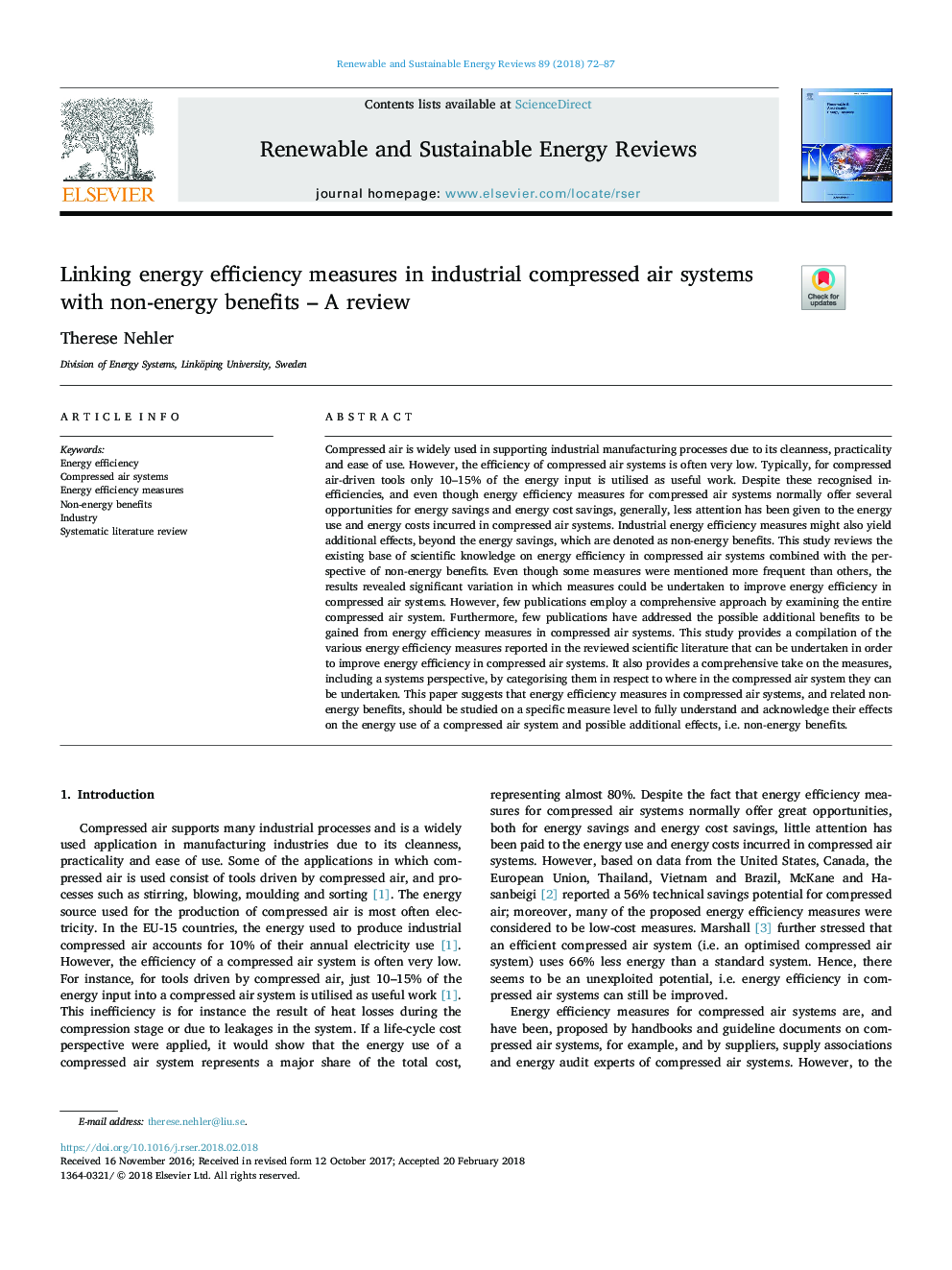| کد مقاله | کد نشریه | سال انتشار | مقاله انگلیسی | نسخه تمام متن |
|---|---|---|---|---|
| 8111337 | 1522295 | 2018 | 16 صفحه PDF | دانلود رایگان |
عنوان انگلیسی مقاله ISI
Linking energy efficiency measures in industrial compressed air systems with non-energy benefits - A review
ترجمه فارسی عنوان
پیوند اقدامات بهره وری انرژی در سیستم های هوای فشرده صنعتی با مزایای غیر انرژی - بررسی
دانلود مقاله + سفارش ترجمه
دانلود مقاله ISI انگلیسی
رایگان برای ایرانیان
کلمات کلیدی
بهره وری انرژی، سیستم های هوای فشرده، اندازه گیری کارایی انرژی، مزایای غیر انرژی صنعت، بررسی ادبیات سیستماتیک،
ترجمه چکیده
هوای فشرده به طور گسترده ای در حمایت از فرایندهای تولید صنعتی به علت پاک بودن، عملی بودن و سهولت استفاده آن مورد استفاده قرار می گیرد. با این حال، بهره وری سیستم های هوای فشرده اغلب بسیار کم است. به طور معمول، برای ابزارهای هوای فشرده تنها 10 تا 15 درصد از انرژی مصرفی به عنوان کار مفید استفاده می شود. علی رغم این ناکارآمدی شناخته شده و حتی اگر میزان مصرف انرژی برای سیستم های هوای فشرده به طور معمول چندین فرصت برای صرفه جویی در انرژی و صرفه جویی در هزینه انرژی فراهم می کند، به طور کلی، مصرف انرژی و هزینه های انرژی در سیستم های هوای فشرده کمتر توجه شده است. اندازه گیری های کارآیی انرژی صنعتی ممکن است علاوه بر صرفه جویی در انرژی، به عنوان مزایای غیر انرژی اشاره داشته باشد. این مطالعه پایگاه پایه ای از دانش علمی در مورد بهره وری انرژی در سیستم های هوای فشرده همراه با چشم انداز مزایای غیر انرژی را بررسی می کند. با وجودی که بعضی از معیارها بیشتر از سایرین ذکر شده، نتایج نشان داد که تغییرات قابل توجهی وجود دارد که در آن می توان اقداماتی را برای بهبود کارایی انرژی در سیستم های هوای فشرده انجام داد. با این حال، تعداد کمی از نشریات، با بررسی تمام سیستم هوای فشرده، یک رویکرد جامع را دنبال می کنند. علاوه بر این، تعداد کمی از نشریات به مزایای احتمالی اضافی که از اقدامات بهره وری انرژی در سیستم های هوای فشرده گرفته شده است پرداخته اند. این مطالعه مجموعه ای از اقدامات مختلف بهره وری انرژی ارائه شده در ادبیات علمی بررسی شده است که می تواند به منظور بهبود بهره وری انرژی در سیستم های هوای فشرده انجام شود. این همچنین اقدامات جامع را، از جمله دیدگاه های سیستم، را با دسته بندی آنها در رابطه با جایی که در سیستم هوای فشرده می توان آنها را انجام داد، فراهم می کند. این مقاله نشان می دهد که اقدامات انرژی در سیستم های هوای فشرده و مزایای غیر انرژی مرتبط باید بر روی یک سطح اندازه گیری دقیق مورد بررسی قرار گیرد تا به طور کامل درک و تأیید اثرات آن بر استفاده از انرژی سیستم هوای فشرده و اثرات اضافی احتمالی، مزایای انرژی
موضوعات مرتبط
مهندسی و علوم پایه
مهندسی انرژی
انرژی های تجدید پذیر، توسعه پایدار و محیط زیست
چکیده انگلیسی
Compressed air is widely used in supporting industrial manufacturing processes due to its cleanness, practicality and ease of use. However, the efficiency of compressed air systems is often very low. Typically, for compressed air-driven tools only 10-15% of the energy input is utilised as useful work. Despite these recognised inefficiencies, and even though energy efficiency measures for compressed air systems normally offer several opportunities for energy savings and energy cost savings, generally, less attention has been given to the energy use and energy costs incurred in compressed air systems. Industrial energy efficiency measures might also yield additional effects, beyond the energy savings, which are denoted as non-energy benefits. This study reviews the existing base of scientific knowledge on energy efficiency in compressed air systems combined with the perspective of non-energy benefits. Even though some measures were mentioned more frequent than others, the results revealed significant variation in which measures could be undertaken to improve energy efficiency in compressed air systems. However, few publications employ a comprehensive approach by examining the entire compressed air system. Furthermore, few publications have addressed the possible additional benefits to be gained from energy efficiency measures in compressed air systems. This study provides a compilation of the various energy efficiency measures reported in the reviewed scientific literature that can be undertaken in order to improve energy efficiency in compressed air systems. It also provides a comprehensive take on the measures, including a systems perspective, by categorising them in respect to where in the compressed air system they can be undertaken. This paper suggests that energy efficiency measures in compressed air systems, and related non-energy benefits, should be studied on a specific measure level to fully understand and acknowledge their effects on the energy use of a compressed air system and possible additional effects, i.e. non-energy benefits.
ناشر
Database: Elsevier - ScienceDirect (ساینس دایرکت)
Journal: Renewable and Sustainable Energy Reviews - Volume 89, June 2018, Pages 72-87
Journal: Renewable and Sustainable Energy Reviews - Volume 89, June 2018, Pages 72-87
نویسندگان
Therese Nehler,
